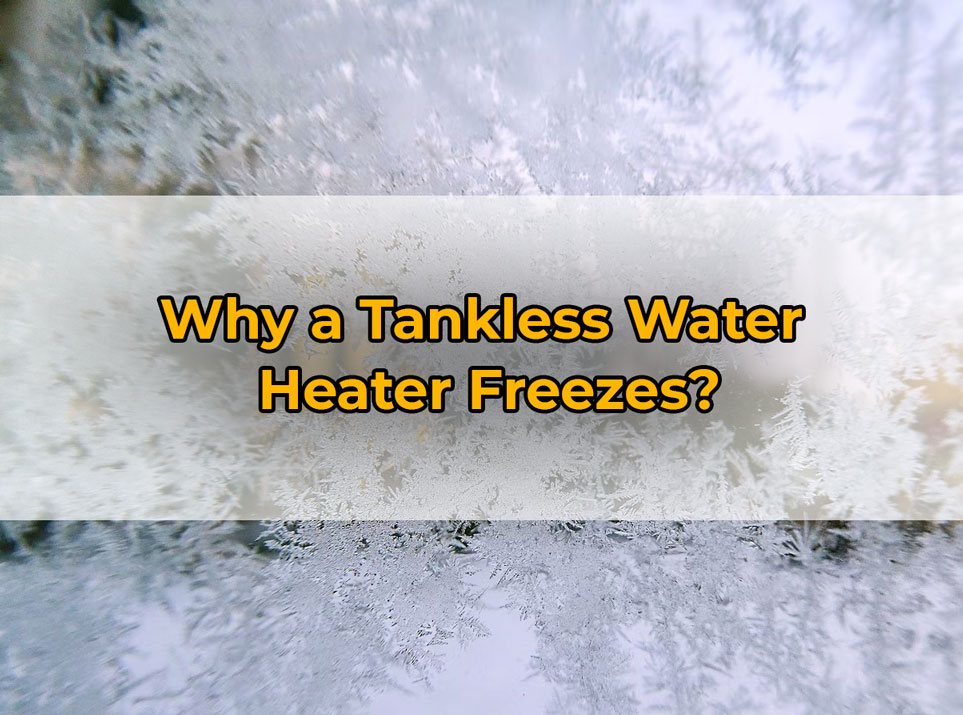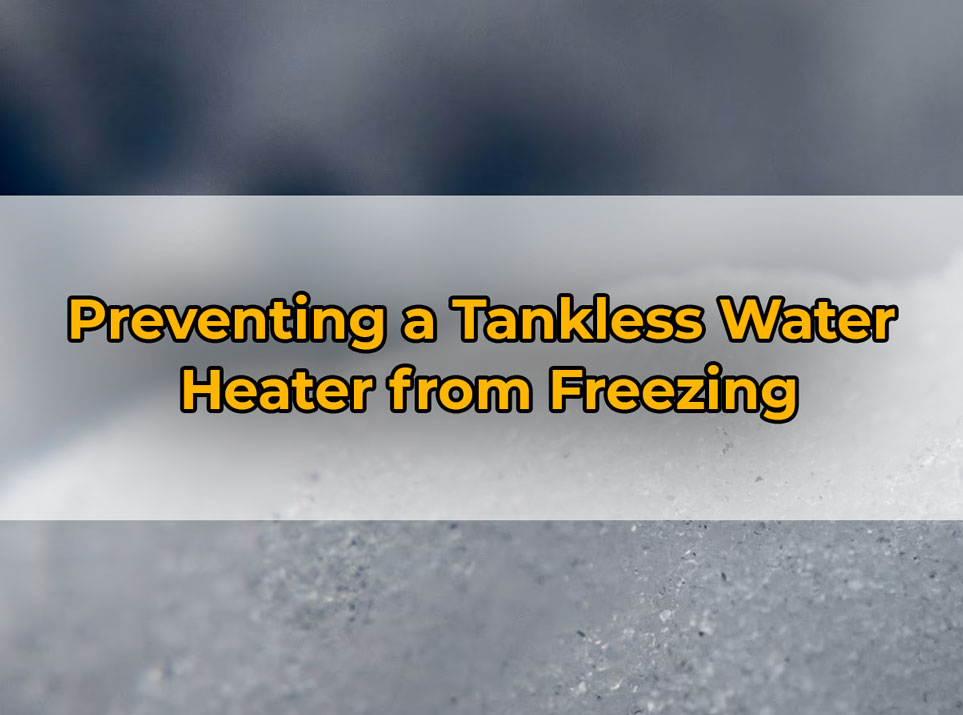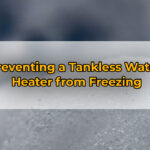When a tankless water heater frozen, it can result in damage to the unit and a significant disruption to your home’s hot water supply.
One of the main causes of a frozen tankless water heater is when it is installed in an area that is not adequately insulated or heated. This lack of insulation leaves pipes vulnerable to freezing temperatures, which can cause them to burst or crack.
Frozen pipes can also block the flow of water through your tankless water heater, preventing it from heating up properly.
It’s essential to take preventive measures before winter arrives by insulating any exposed pipes and ensuring your tankless water heater is installed in a heated area.
Here is some ideas on tankless water heater frozen, how to handle and solve it in the right way!
Why a Tankless Water Heater Freezes?

To understand why your tankless water heater frozen, you need to know the possible reasons. Here is the detailed explanations:
1. Low temperature settings
The freezing of tankless water heaters can occur when the external air temperature drops below 30 degrees Fahrenheit. Avoiding this requires temperature settings to never dip below 32 degrees Fahrenheit.
To prevent this, an anti-freeze kit should be installed in colder areas. This kit circulates anti-freeze through the heat exchanger coils to avoid freezing.
However, these kits are not 100% effective. A power outage or a heater failure could cause damage. Therefore, installation and regular maintenance is important.
A study by Consumer Reports reveals that tankless water heaters use 22% less energy than storage-tank models. Investing in proper installation and maintenance can save on repair costs and electricity bills.
Winter insulation is beneficial for the water heater too!
2. Insufficient insulation
Insufficient insulation can cause your tankless water heater to freeze. It’s ’cause when it’s installed indoors, it’s exposed to colder temperatures, leading to heat loss and lower temperatures inside the unit.
To avoid this, make sure you install the unit in a spot that allows for proper insulation. Plus, you can add external heating devices or insulating blankets to keep the desired temperature.
Also, inadequate clearance around the unit can let cold air in, reducing efficiency and damaging components. So, find an area with enough clearance from other objects.
Pro Tip: Regular maintenance and inspection of your tankless water heater can help detect potential issues, like insufficient insulation. Don’t blame Jack Frost, it’s likely due to improper installation. Just make sure it’s not haunted…yet.
3. Improper installation
Incorrect installation of a tankless water heater can cause several issues, such as freezing. Poor installation affects efficiency and performance, making it vulnerable to weather. How does this happen?
- The exterior vent pipes are incorrectly positioned.
- Electrical connections are faulty.
- There is lack of insulation material around hot water pipes.
- Drainage system for excess water from pressure relief valve is inadequate, causing hot water heater leaking and damage.
- Gas pressure requirements don’t match, resulting in insufficient heat production leading to possible ice buildup.
If freezing or any other issue is suspected, turn off the heater right away. Get professional help to address the issue. Wrong instructions from misleading websites or repair manuals may cause further harm or safety risks on your bathroom.
Modern heaters are less likely to freeze, however, professional installation is still needed to prevent malfunctions and hazards. In some cold regions like Canada and Alaska, inappropriate installation led to frequent freezing.
Ice blockages could cause expensive repairs or replacements. If your shower looks like an icicle sculpture garden, your tankless water heater has gone freeze-happy!
Symptoms of a Frozen Tankless Water Heater
To identify the symptoms of a frozen tankless water heater, check for certain signs that indicate an issue with your unit. Addressing these symptoms early can avoid future issues with your tankless water heater frozen.
1. No hot water
No hot water? Could be a malfunctioning heater. It could be a blown fuse, a broken heating element, or mineral buildup. It could also be an error code on the control panel. Resetting the unit might help.
In cold weather, the heater could be frozen. If so, defrost it.
Sometimes, even after turning up the thermostat and increasing flow rate, no hot water comes out. It may be due to debris build-up. Flush the system to fix the problem.
If you’re having trouble, call a pro. They’ll find efficient solutions and repairs. Low water pressure? That may be the culprit.
2. Low water pressure
Water Flow Inconsistency – Oh No!
One of the tell-tale signs of a tankless water heater frozen is an inconsistent water flow rate. This might mean a reduced flow or lopsided hot/cold temperatures. The problem occurs when the heat exchanger gets blocked, resulting in low pressure.
Left untreated, the issue can get a lot worse. It could lead to total blockage and expensive repairs or even a new unit. So it’s vital to get a pro on the job as soon as you spot any symptoms. Check also: water heater pilot light.
It’s essential to understand that not all low pressure is caused by a frozen tankless water heater. There could be other underlying issues. That’s why it’s important to get an expert to inspect your system – rather than guessing what the cause might be.
In short, low pressure in your tankless water heater could be a sign that something’s wrong. If left unchecked, this could lead to serious damage. Make sure to call a professional straight away for a diagnosis and repair. Check also: How to Increase Water Pressure in Shower.
2. Strange noises
Unusual sounds from your tankless water heater? Clanging metal, gurgling, or hissing or water heater sounds like a tea kettle? Turn off the unit and call a technician. Worn out heating elements could be the problem – or mineral deposits blocking the flow of water.
Issues can lead to corrosion, rupture, or even water heater explosions. Get professional help before it’s too late.
Energy Star recommends regular maintenance to increase efficiency up to 30% – save energy and prolong the life of your heater. Get those hot showers back with these easy steps!
Steps to Thaw a Frozen Tankless Water Heater

To thaw your frozen tankless water heater, follow these steps with the help of our guide on ‘tankless water heater frozen’.
1. Turn off power supply and water source
To thaw a frozen tankless water heater, it’s important to turn off the power supply and water source first. Here are five steps to do that:
- Locate the circuit breaker that controls power to the heater.
- Switch off the circuit breaker.
- Turn off the water inlet valve for hot and cold lines connected to the heater.
- Open all hot-water taps connected to the heater to release pressure in the unit.
- Check the gas supply is off if the heater is gas-powered.
Refer to your heater’s manual for unique instructions. For safety, wear protective gear like gloves and safety glasses when working with electrical components. Check also: best electric tankless water heater. And be prepared to crawl around in tight spaces to find frozen parts.
2. Identify frozen parts
Find the frozen parts of a tankless water heater by looking for:
- Any leaks around the unit.
- Frost on exposed pipes and plumbing connections.
- Frayed or damaged switches, wires, etc. due to condensation.
- A drop in temperature along the pipe system.
- No heat being generated by the tankless water heater.
Be careful! These signs may also appear in non-frozen conditions. So, consult a pro before thawing. Wait till exterior temperature is above freezing too. Lastly, remember: heat is the solution, not the problem.
3. Use a heat source to thaw frozen parts
A frozen tankless water heater can cause plumbing damage. Thaw it to avoid costs. Here’s how:
- Turn off the power or gas.
- Identify frozen parts.
- Use a hairdryer or heat gun to thaw.
- Wait 10 minutes before turning the power back on.
Don’t use an open flame! If thawing fails, hire a pro.
To prevent future problems, hire pros for checkups. Otherwise, you’ll get cold showers and a big bill.
4. Check for damage and repair if necessary
Identify a frozen tankless water heater? Check for damage and repair if necessary! Neglect this and you could face severe consequences. Follow this four-step guide:
- Turn off power supply from breaker panel or disconnect all sources of power.
- Examine internal and external parts for cracks, leaks, and other visible damages.
- If you spot leaks/cracks, turn off water supply. If tiny cracks/leaks, seal with high-temp putty.
- If extensive damage, contact certified plumber for best course of action.
Remember: damages left unrepaired can worsen over time and compromise functionality and safety. Also be on the lookout for corrosion which can cause blockages in pipes leading up to your unit. Check also: Tankless Water Heater Vs Tank.
Safety first: wear protective gear like gloves and goggles and ensure proper ventilation. Don’t take chances – fix the tankless water heater immediately before thawing!
Preventing a Tankless Water Heater from Freezing

To prevent your tankless water heater from freezing during winters, increase the temperature settings, insulate pipes and unit properly, install a recirculation system, and install a freeze-proof valve.
1. Increase temperature settings
Avoid a tankless water heater frozen by adjusting the temperature settings. Higher degrees can help the water flow and the system’s proper functioning. Here’s a 5-step guide to increase the heat:
- Locate the thermostat – it’s usually near the middle.
- Turn off the power supply to be safe.
- Adjust the thermostat with a screwdriver or the manufacturer’s instructions.
- Check the outlet temperature with a thermometer.
- Power back on when you’ve achieved the optimal temperature (around 120 Fahrenheit).
Be careful, higher temps can cause scalding. Follow safety instructions.
Clean and flush water heater the system to remove mineral buildups. This helps the efficiency and lifespan of your tankless heater. Keep it warm this winter!
2. Insulate pipes and unit properly
Prevent your tankless water heater from freezing by insulating the pipes and unit. This will keep it warm in the cold months and stop frozen water damage. Here’s how:
- Clear debris and dust – Clear the area around pipes and unit for better insulation sticking.
- Choose insulation – Fiberglass or foam insulation is great for keeping the heat in.
- Cut to size – Cut the insulation according to the measurements of the pipes and unit.
- Wrap and secure – Wrap each section of pipe with insulation. Make sure there are no gaps.
- Cover the whole unit – Cover all exposed sections and fittings on the heater with insulation.
Remember to tankless water heater maintenance a consistent temperature. Not doing this can cause costly damage. Install a recirculation system to get hot water flowing like a river. No more frozen pipes!
3. Install a recirculation system
To protect your tankless water heater from freezing, you must install a recirculation system. This will make the water travel in a continuous loop and keep the temperature regulated. Here are three easy steps to help you out:
- Choose the Right System: Select one that is compatible with your tankless water heater and fits your household’s needs.
- Install the System: Place the recirculation pump close to your water heater. Connect it to the hot and cold-water lines.
- Program: Program your recirculation timer to run during peak use hours. This ensures hot water is always available and reduces the possibility of freezing.
Safety measures such as electrical wiring must be taken into account if you are to install a recirculation system. It can also save energy costs by eliminating the need for running water. Don’t miss out on this great investment—call a licensed professional today! In addition, install a freeze-proof valve to keep the hot water flowing and the cold winter air out.
4. Install a freeze-proof valve
A freeze-proof valve is a must-have for a tankless water heater! Sub-zero temperatures can cause water inside the system to expand and damage the components. Here’s how you install it:
- Locate the incoming cold-water line near the water heater.
- Turn off the main water supply line.
- Cut out a section of the cold-water line and install the freeze-proof valve.
- Reconnect pipes, turn on the main water supply line and test.
Having proper frost protection is essential to avoid costly damages. One person had to pay over $10,000 for repair work due to frozen pipes.
To avoid this, install a freeze-resistant valve and take other preventative measures. Don’t let freezing temperatures freeze out the hot water; with regular maintenance, you can thaw out any disasters! Check also: Anode Rod Water Heater.
Conclusion
Prevent Problems With Your Tankless Water Heater!
Maintenance and precautions are essential to avoid freezing. Don’t neglect your water heater, or you could be facing costly repairs or even a replacement.
Keep your expensive investment safe with these simple steps:
- Insulate pipes and water heaters properly
- Don’t use foam insulation, as it leads to improper ventilation and fires
- Shut doors to avoid drafts
- Use heating strips and heat tapes on the pipes
- Drain hoses frequently to stop freezing
Be aware of even minor leaks, as they can cause more damage in time. Monitor your unit’s status for necessary adjustments. Regular care is needed for optimal efficiency.
Don’t wait until it’s too late. Follow these maintenance tips to protect yourself from potential damage and save on repairs or replacements. Take charge of the maintenance today!
Are tankless water heaters more likely to freeze?
The short answer is no; tankless water heaters are not more likely to freeze than traditional tank-style water heaters.
In fact, because tankless water heaters do not have a large reservoir of standing water like traditional models, they may be less prone to freezing.
Tank-style units can experience frozen pipes and tanks if they remain unused for long periods or are exposed to extremely cold temperatures. On the other hand, tankless models use a heat exchanger that warms up the water as it flows through the unit, so there is no standing water that could potentially freeze.
What is the maximum temperature for a tankless water heater?
The answer to this question depends on the make and model of your tankless water heater. Most manufacturers set the maximum temperature to 140°F to prevent scalding, which can cause serious burns. However, some models may allow you to adjust the temperature range from 100°F to 185°F.
Do tankless water heaters work in very cold climates?
The answer is yes, but with some caveats. Tankless water heaters can function well even in frigid temperatures as low as -22°F (-30°C), thanks to their advanced technology and design.
Unlike traditional tanks that store large amounts of hot water and lose heat over time, tankless units only heat up the exact amount of water needed at any given moment. This not only saves energy but also prevents pipes from freezing by heating them continuously.
“There is no real ending. It’s just the place where you stop the story.”






